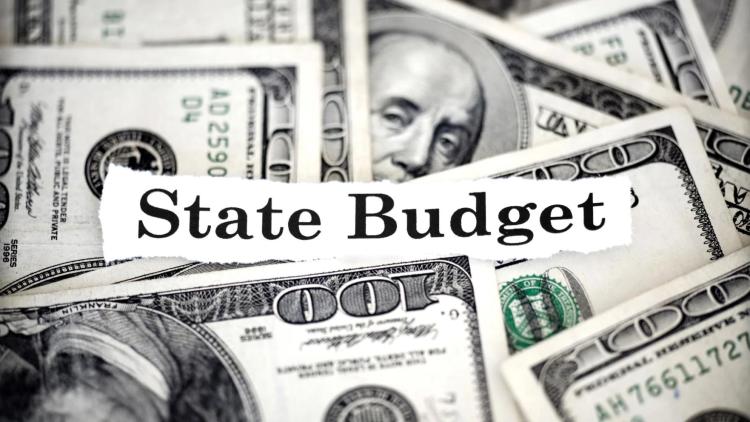When economies falter, governors respond similarly, regardless of party
Political scientists find that partisan divide shrinks among governors who are responding to economic downturns
In today’s hyper-partisan environment, do states led by Republican governors have different budgetary priorities than those led by Democrats?
They do indeed, in normal economic times. However, in times of negative economic shocks—either within a state or in neighboring states—Democratic and Republican governors tend to share a similar budgetary response by increasing spending in certain categories while also cutting discretionary spending.
That’s the assessment made in a research paper, “Bad times keep us together: Policy priorities and economic shocks,” co-authored by Andrew Q. Philips, associate professor in the University of Colorado Boulder Department of Political Science. Social Science Quarterly published the work this year.

Andrew Q. Philips, an associate professor in the University of Colorado Boulder Department of Political Science, studies political economy, specifically budgets as a reflection of government priorities.
While much has been made of the political divide between Republicans and Democrats, research on their spending priorities at the state level in several budgetary categories remains somewhat sparse, according to Philips, whose research focus includes political economy, specifically budgets as a reflection of government priorities.
To gauge the budgetary priorities of state governments, Philips and his three co-authors focused on 10 budgetary categories that compose most state expenditures: elementary education, higher education, transportation, social services, housing, natural resources and sanitation, public safety, labor market policy, interest on the debt and “other.” The data came from U.S. Census Annual Survey of Government Finance for the 48 contiguous states between the years 1977 and 2007.
Partisan spending priorities
“Our research finds support for the idea that partisanship drives the allocation of budgetary expenditures. So, to answer the question: Do Democratic and Republican governors have different ideological priorities regarding spending? In good economic times, the answer is ‘yes,’” Philips says.
“That makes sense, and we are certainly not the first ones to show that—although I believe we do it in a different way, because of the compositional approach we take to spending, rather than focusing on certain categories, such as unemployment.”
The research found that Democratic governors tended to spend comparatively more on labor market policy (which includes unemployment, workers’ compensation and jobs training programs) as well as housing, while Republicans tend to spend a bit more on public safety and transportation, according to Philips.
“A lot of these are the usual suspects,” he says of spending priorities relating to a governor’s political affiliation. “I think the cooler part of the paper is: What happens when the economy is not doing well? In those cases, what we find is that it actually matters less what the party of the governor is, because no matter their (party affiliation), they tend to respond in a similar manner to these shocks that we look at within a state.”
For example, if a state’s unemployment rate increases, Philips says both Democratic and Republican governors will allocate a larger portion of the budget to cover unemployment, worker’s compensation and job retraining. At the same time, because most states are required to have balanced budgets, increases in those segments will come at the expense of discretionary expenses in other areas.
“Economic pressures constrain the ability of governors to act,” Philips explains. “And so, I might be a Republican governor who wants to increase spending on public safety as a percentage of the budget, but if—all of a sudden—there’s more unemployment, I likely have to address that more direct need. So, even if public safety is what I want to spend more on, I need to address the more pressing need.”
It’s not surprising that governors—regardless of party affiliation—pursue similar policies when faced with economic shocks, because as politicians, they face pressures to act from other elected officials, the media and—perhaps most importantly—voters, Philips says.
“The worry is that, if you are an incumbent and the (state) economy is not doing well, there’s lot of evidence from political science that they get punished at polls,” he adds.

“If there are negative economic shocks in nearby states—no matter the partisanship—they (governors) tend to respond relatively similarly,” says CU Boulder political scientist Andrew Philips
Still, because budgets are established in advance, Philips says there’s generally not a lot a governor can do in the immediate aftermath of an economic shock.
“I think the overarching statement is that, in the short run, like a one-year period, they tend to do the same thing—and often they often don’t do much,” he says of both Democratic and Republican governors. “These (state) budgets are really sticky. They get allocated the year before … and it’s hard to make changes, even if they (governors) want to.”
Another possible economic shock is a drop in a state’s per capita personal income, which Philips says in the longer term (five years or more) can reduce budgets for social services, labor market policy, public safety and interest on the debt.
In that case, both Republican and Democratic governors will cut spending for labor market policy, he says, adding that Republican governors will cut it slightly more, as a percentage of the budget. And Democratic and Republican governors will both cut funding for elementary education and higher education, although Democrat governors will cut expenses by a larger amount, percentage-wise, he says.
Negative effects from neighboring states
Philips says another interesting aspect of the paper is that it found economic shocks to states had correlating effects on the budgets of neighboring states.
“I think there are various mechanisms as to how that could happen,” he says. “For example, there could be a common factor, such as the national economy going down and everyone is receiving this simultaneous shock. Or, there could be a spillover effect. For example, on the East Coast, where the states are pretty close together, it’s not uncommon for people to live in New Jersey and commute to New York. So, if the economy is suddenly doing poorly in New Jersey, that could be felt in New York, and in how New York responds to setting its budget.”
When a neighboring state experiences negative economic shock in the form of a decrease in personal income, in the short run, both Republican and Democratic governors in their home state respond in nearly identical ways, by sharply decreasing elementary education and increasing social services and labor market policy, the research paper found.
“If there are negative economic shocks in nearby states—no matter the partisanship—they (governors) tend to respond relatively similarly,” Philips says.
Notably, the study illustrates that that for negative economic shocks—specifically, increases in unemployment or decreases in personal income—budgetary reactions are similar when the shock happens within a state versus when a shock occurs in surrounding states, he adds.
As a governor, I might wake up to an economic crisis, and even if at the end of the day I want my budget to look like budgetary menu A, the events at the time might force me to make my budget look like budgetary menu B."
Phillips says he believes there are many aspects of budgetary policy at the state level that could still be explored. For example, Philips says his paper compared states where the Republican or Democratic governor also had a state legislature of the same party, which raises the question of whether a governor serving in a state where the legislature is controlled by the opposition party would be required to make more compromises to get things done.
Another possible area to study: Comparing whether governors who are term-limited with those who are not to determine if it had any impact on whether governors kept their budget priorities after experiencing an economic shock.
Still, Philips says he believes his research has broken new ground on the similarities in budgetary priorities between Republican and Democratic governors during in times of economic shock, particularly when partisanship appears to be on the rise.
“It’s very easy in today’s age to think that the policies of Democrats and Republicans couldn’t be more different, and certainly on the national stage I think that’s true to some extent,” he says.
“For a variety of reasons, during periods of economic shock, I think our research has shown that it’s a bit different at the state level. Because, as a governor, I might wake up to an economic crisis, and even if at the end of the day I want my budget to look like budgetary menu A, the events at the time might force me to make my budget look like budgetary menu B. And there’s a trade-off between: When can I stick with my priorities versus being stuck with menu B.”
Did you enjoy this article? Subscribe to our newsletter. Passionate about political science? Show your support.

